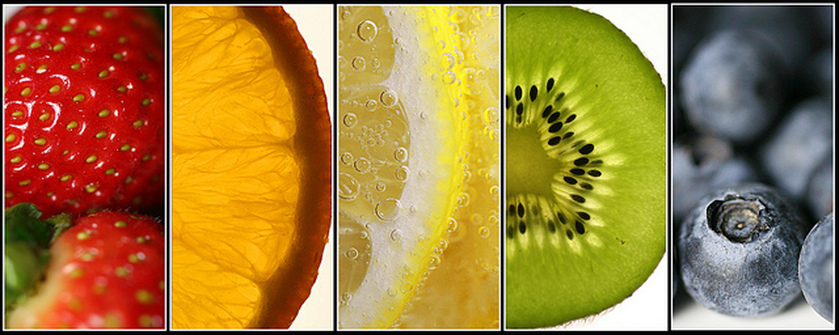A few years ago I was discussing how to provide healthy food to babies, toddlers, and young children with my sister-in-law, a registered dietitian. More recently I read an article in the Canadian Chiropractor magazine that was of a similar topic. Here is some food for thought for Nutrition Month!
The food discussed is specific to fruits and vegetables.
The Colours of the Rainbow
You’ve most likely heard about including a variety of fruits and vegetables in your diet. The reason for this is that different foods offer different nutrient profiles (different combinations of vitamins and minerals). By eating a variety of foods you are more likely to achieve a complete profile. As one food may lack in some vitamins, another food will be able to compensate by having those vitamins but less of others. This is like a team that is working together to achieve a goal (such as striving for optimal health and function of your body).
One way to achieve this is through variety of colour. Same coloured fruits and veggies tend to have similar nutrient profiles. As a result, you don’t want only one colour of fruits and veggies on the team. To have a well balanced team (diet), the team members need to compliment each other in their strengths and weaknesses. When it comes to team sports, it is important to have substitutes or multiple players that are available for each position. Luckily, in the land of fruits and vegetables, we have many options available to us. Please welcome to the plate: Team Rainbow!
First off, on the left wing, we have the delicious Reds and Pinks. Introducing tomatoes, red peppers, watermelon, pink grapefruit, strawberry, and cherries!
In the defense position, the wonderful no rhyme Oranges. Introducing carrots, mango, sweet potatoes, pumpkin, apricots, nectarines, and the not-so-fuzzy peaches!
In the center we have the always sunny Yellows. Introducing yellow peppers, corn, acorn squash, pineapple, lemons, and (yellow) pears!
As team captain(s) and lead position we have the Greens. Introducing asparagus, avocado, artichokes, kale, broccoli, arugula, green apples, and kiwi!
On the far right, we have the Blues and Purples. Introducing eggplant, purple cabbage, plums, prunes, blueberries, and blackberries!
Finally, the medical team (not part of the rainbow, but an integral part of the team none the less), also known as the Whites. Introducing garlic, onions, mushrooms, fennel, cauliflower, bananas, and the white pear!

As you can see, the team is stacked (and there are more than are listed here). And if each position is played properly, your body is likely to get the best combination of nutrients to help it function properly.
Healthy options
So, how can we use a variety of options to help achieve healthier eating for ourselves and our kids?
Choice. Choice through healthy options. The basis of this idea is Ellyn Satter’s Division of Responsibility in Feeding (the “what”). Give a variety of healthy options and let children decide what they want to eat. The great thing about this is that regardless of what they choose, what they like, what they don’t like – it’s healthy!
You can use the rainbow idea to provide options of different coloured food, as well as options within the grouping. (Maybe pink grapefruit is just having a bad day, but watermelon is fresh and ready to seize the day).
I found my niece and nephew at my place a little while back. I hadn’t had a chance to eat the cut up veggies I’d made for myself for work so I grabbed the container and started eating while hanging out with the two kids. Immediately, they dug in to the veggies. I had a few different options: carrots, cucumber, and red pepper. The cucumber disappeared first, then they both started on the carrots. I took a piece of the red pepper and shortly after that noticed my niece sneaking looks at me (2 years old). Shortly after that she took the other piece of red pepper.. she nibbled on it for a little bit, then switched back to the carrot, then tried a nibble at the red pepper again, then put it back and continued on with her carrot. I found the whole scenario intriguing (and cute). I was also proud that I could be a role model for eating, and trying new, healthy foods.
Being a role model
Although my niece didn’t like the red pepper, it was still a positive event. She tried something new, with a different texture, taste, and colour. If you don’t offer variety or choice, you elimate the chance that they will like it and have a new healthy food to enjoy. It may also take time, or multiple occasions of trying something before it is accepted.
In this case, she simply replaced the pepper with a vegetable that she did like, so no downside. It also reinforced the importance of role modeling. If the pepper had been there, but I hadn’t been eating it, she may not have tried it. But because I was eating it, she wanted to give it a try too.
This works both ways. You are a role model, regardless if it is for healthy or unhealthy eating. If you try hide food, smuggle food, they will want it – and not for the reasons that you want it, but because you’re eating it (and don’t want them to eat it).
Have fun with food! It can be a great social, tasty, and healthy experience.
Resources
EatRight Ontario provides nutritional information by registered dietitians of Ontario. This is a great online resource, and they provide email and phone service for anyone with specific questions.
Ellyn Satter, a dietitian and family therapist, has created the Division of Responsibility in Feeding. I briefly touched on the “what” portion but there is more if you’re interested.
Rainbow Plate is a company that strives for eating to be an adventure in variety. They provided the article in the Canadian Chiropractor magazine.
